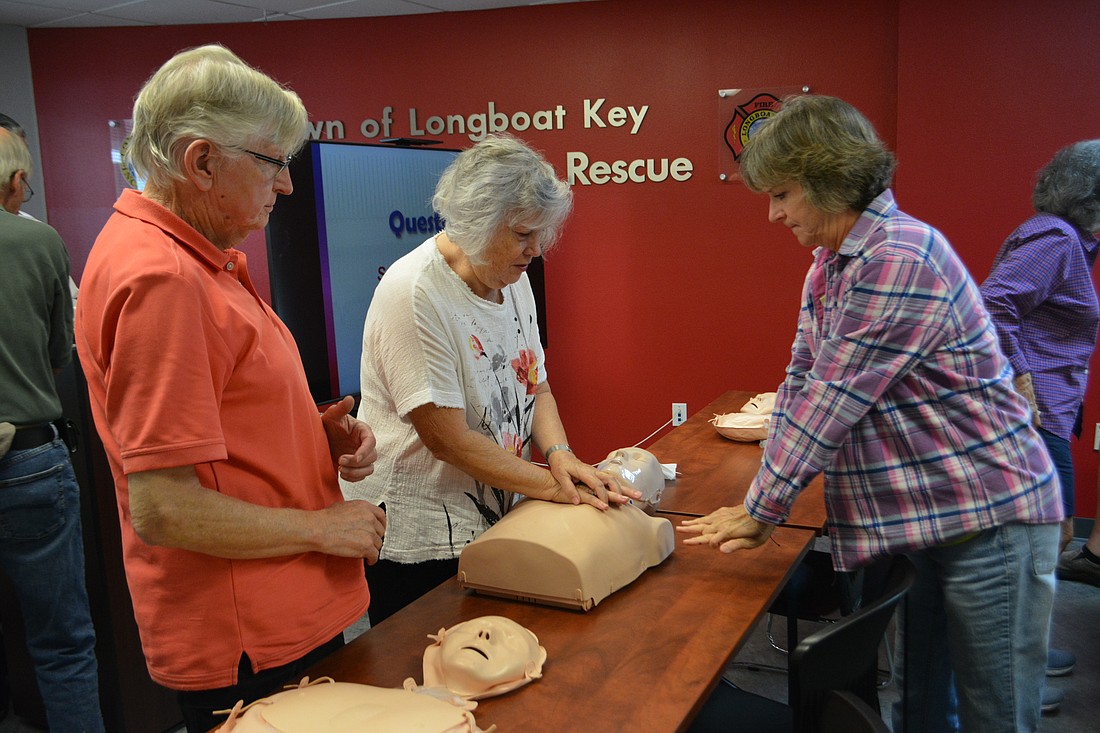- November 5, 2025
-
-
Loading

Loading

The Longboat Key Fire Departmen's CPR training course has returned for the first time since the pandemic, acting as a refresher course for some attendees and a first look for others.
The course does not certify attendees in hands-only CPR or the use of an automated external defibrillator, but it does provide them with the basic skills that can be the difference between life and death.
Fifteen people attended the department’s Feb. 10 course.
“We’ve done (CPR training) several times before, but that was years ago,” Pam Toft said. “We wanted to take this as a refresher.”
Toft and her husband, Graham, took the course together after encouragement from their daughter to keep their knowledge up to date.
Learning the difference between cardiac arrest and a heart attack and which case to use CPR for stood out to the couple as information they had not learned before.
When someone is experiencing a heart attack, CPR should not be administered as they are already conscious with a pulse, Fire Chief Paul Dezzi told attendees.
Ensuring no obstructions, such as a shirt or under garments, when administering CPR is key to performing it properly.
The individual performing CPR should aim to do between 100 and 120 compressions per minute, pressing about 2 inches into the chest.
For each minute chest compressions are not being performed, the likelihood of that person surviving decreases by about 10%, Dezzi said.
Of course, it is essential that emergency personnel are notified of the issue first, but compressions should begin as soon as possible afterward.
Pat Watral was among attendees with past CPR experience. She used to be a lifeguard, which requires certification.
“I wanted to make sure my knowledge was current,” Watral said. “The updates he taught us were faster and easier to remember.”
Updates included how to determine where to place hands. Previously, Watral was taught to measure two fingers above the diaphragm, but Dezzi instructed the class to place their palms in the middle of the nipple line.
The placement is the same; it’s just a faster determination.
At the conclusion of the class, Dezzi gave a tour of the station to those interested and discussed further the responsibilities and day-to-day in the department.
Watral pinpointed the relationship between Manatee County, Sarasota County and the town as information she had always been curious about.
When learning how to use an AED, a few of the attendees commented that they were unaware that using one was as simple as placing patches on the patient and waiting for further instructions from the machine.
After the AED analyzes the heart rhythm, it will provide the prompt to either administer the shock or that a shock is unnecessary. Administering the shock is as easy as pushing the button labeled “shock.”
The department is hosting courses throughout the months of February and March. All the courses are free, but the majority of them have been fully booked. Courses last one hour and are free. Class sizes are limited to 18 people each. All of the March classes still have spots available.
“Usually, the later classes fill up once people have attended and tell their friends and neighbors about it,” Dezzi said in an interview last month.
It is not uncommon for residents to come back after their first training as a way to receive a refresher course, which the department encourages, he said.
This year, instead of outsourcing training, the department has opted to use on-duty in-house firefighter/paramedics to teach residents. This also allows for the department to host more training dates than if they were to contract out another agency to do it.
Dezzi led the entirety of the Feb. 10 course as firefighter/paramedics completed required training.